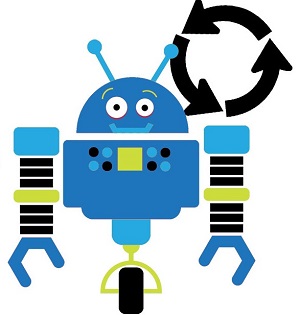Robotic Process Automation (RPA) is a huge buzzword right now, even though the technology has been available for a few years. The reason it’s trending is because thousands of companies are implementing RPA every single year, with percentages growing exponentially.
According to estimates from PwC, about 45% of work activities can be automated. So why let software do it? Simply put: the world generates more data than ever and companies need to keep up. RPA allows for automating time-consuming manual processes and letting your employees focus on higher level (and ideally, more rewarding) work.
Read on for more about RPA, or use our quick links to jump to a section:
- What is Robotic Process Automation (RPA)?
- How Does RPA Work?
- What are the Benefits of RPA?
- What Processes are Right for RPA?
- What are Some Real-Life Examples and Use Cases of RPA?
- What Do I Need to Do to Get Started with RPA?

What is Robotic Process Automation (RPA)?
Despite the name (and our cute robot picture), Robotic Process Automation has nothing to do with actual, physical robots. RPA is specialized software (or “bots”) that can learn repeatable business processes and perform them without human interaction. It’s essential for linking separate systems if you don’t have APIs or extensive IT resources.
For example, let’s say you spend a bunch of time every day copying and pasting data from one system into another. An RPA “bot” can watch screen movements and keystrokes and learn what needs to be copied. Also, if you’ve ever programmed Excel macros, RPA works similarly, but with a lot less programming.
Best of all, RPA doesn’t require any programming skills or heavy maintenance by your IT department. It acts like another employee, logging into systems, scraping data, and filling out forms. So, while your bot does the grunt work (also known as busy work, swivel chair work, etc.), your employees can focus on more important work like strategy and special projects.

How Does Robotic Process Automation (RPA) Work?
Essentially, RPA works as another employee, just faster, more consistently, and 24 hours per day.
The process in its simplest form looks like this:
- IT/an administrator installs or activates the RPA software on your computer system
- RPA watches screen and mouse movements, along with keystrokes
- RPA records the process and uses AI to analyze the steps
- RPA does the process to your specifications, which includes running automatically when new data is found
- RPA continues to do the process until you tell it to stop
RPA can be turned off or reprogrammed at any time, which also makes it great for work that you may have previously hired temporary workers to complete.
What are the Benefits of RPA?
The biggest and most immediate benefit of implementing RPA is that you can speed up cumbersome, repetitive, manual processes. A process that can take even the speediest human an hour can be cut down to minutes (or even seconds!) with robotic process automation.
Here are some of the other benefits:
- Increase in productivity
- Reduction of process time
- Consistency of task completion
- Extreme accuracy and reduction in errors
- No programming skills or APIs required
- 24/7 processing ability
- Lower costs
- No need to switch to new systems or software
- Full compliance with audit trail history
- Potential return on investment of anywhere from 30–200%
What Processes are Right for Robotic Process Automation?
Any process that is highly structured and rules based is a great candidate for robotic process automation.
It’s important to note that any process that requires a human decision can’t be completely automated. You’re still going to need a human to make a decision. But if most of the process before and after is very structured, then you can have RPA and human employees work together to complete it.
Other things to look for in a process that could be performed by RPA:
- Extremely repetitive and takes a substantial amount of time
- Requires manual data entry tasks across multiple systems or applications
- Includes a lot of extracting, reformatting, merging, copying, or pasting data
- Uses two monitors to copy data from one system into another
- Generates emails or fills out forms
You can even have RPA go out and scrape data from social media or websites. So, if you’re in the marketing department, you can have your “bot” go out and scrape follower numbers from all of your competitors on all of their social media sites and it will deposit it nicely in a spreadsheet for you.
What are Some Real-Life Examples and Use Cases of RPA?
Okay, so that all sounds good, but sometimes real-world examples are best to show what a “bot” can do for your business.
Here are ways that RPA is currently used in companies:
- Financial institutions use it to pull credit reports to speed up underwriting and loan processing
- HR departments use it to read timesheets and generate paychecks
- Accounting departments use it to continually check for new purchase orders and upload them into ERPs/LOB applications
- Recruiters use it to read all submitted resumes and cover letters. Documents with the correct keywords are automatically routed to the proper recruiter
- IT departments use it to set up user accounts when their company hires new employees or to close accounts when an employee leaves
- Sales teams use it to generate and deliver invoices
And that’s just a sampling. There are uses for RPA no matter your industry or department.
What Do I Need to Do to Get Started with RPA?
It’s important that you start with your end goal in mind. What process do you need to be faster? Which is the least disruptive with the most benefits? The most successful RPA implementations include clear communication and goals, so you need to make sure that everyone is on the same page.
Identify Your Process
The first thing you’ll need to do is to identify a process that’s good candidate for automation (see criteria from section What Processes are Right for RPA?). It should be simple in nature, but also a huge pain point for your current state.
Have a process that never gets completed on time? Need something completed but you can never find the resources? Have one (or multiple) processes programmed by IT to run overnight? These are all signs that a task is the right candidate for robotic process automation (and you don’t necessarily need IT to oversee it!).
Assess Current Software
Before you do a deep dive into researching robotic process automation solutions, take a look at what software you’re currently using. Many programs–including leading LOB, ERP, and document and information management software–have already rolled out RPA “bots.”
For example: both Digitech and Laserfiche feature RPA technology with their document management software. Depending on whether you have on-premise or cloud software, this may already be part of your license, or can be added for a small fee.
If you’re happy with systems you have, and their RPA software can do what you need, then a huge part of the implementation is already done!
Research New RPA Software
If none of your current software has RPA capabilities, then start researching other alternatives. It’s best to dive right in with a search for the “best RPA software” and start reading reviews and product specifications. Be careful on top ten review sites, as sometimes companies pay for better rankings and reviews.
Once you have a list of a few options, reach out to the companies or resellers and ask for demos or a free trial.
If you don’t have the time or resources for a lengthy research period, you may want to consider hiring a consultant to work with you on selecting the best software.

We covered a lot, so here are those section links again if you want to jump back:
- What is Robotic Process Automation (RPA)?
- How Does RPA Work?
- What are the Benefits of RPA?
- What Processes are Right for RPA?
- What are Some Real-Life Examples and Use Cases of RPA?
- What Do I Need to Do to Get Started with RPA?
Otherwise, we hope this guide was a good starting point in your RPA journey!
If you’d like to know more about RPA options and/or how to take your document-based processes to the next level, please contact us or call (630) 321-0601. We’re passionate about finding the right solution for your business needs.
Have a question or something you’d like to add? Find us on Twitter or LinkedIn. We’d love to hear from you!

